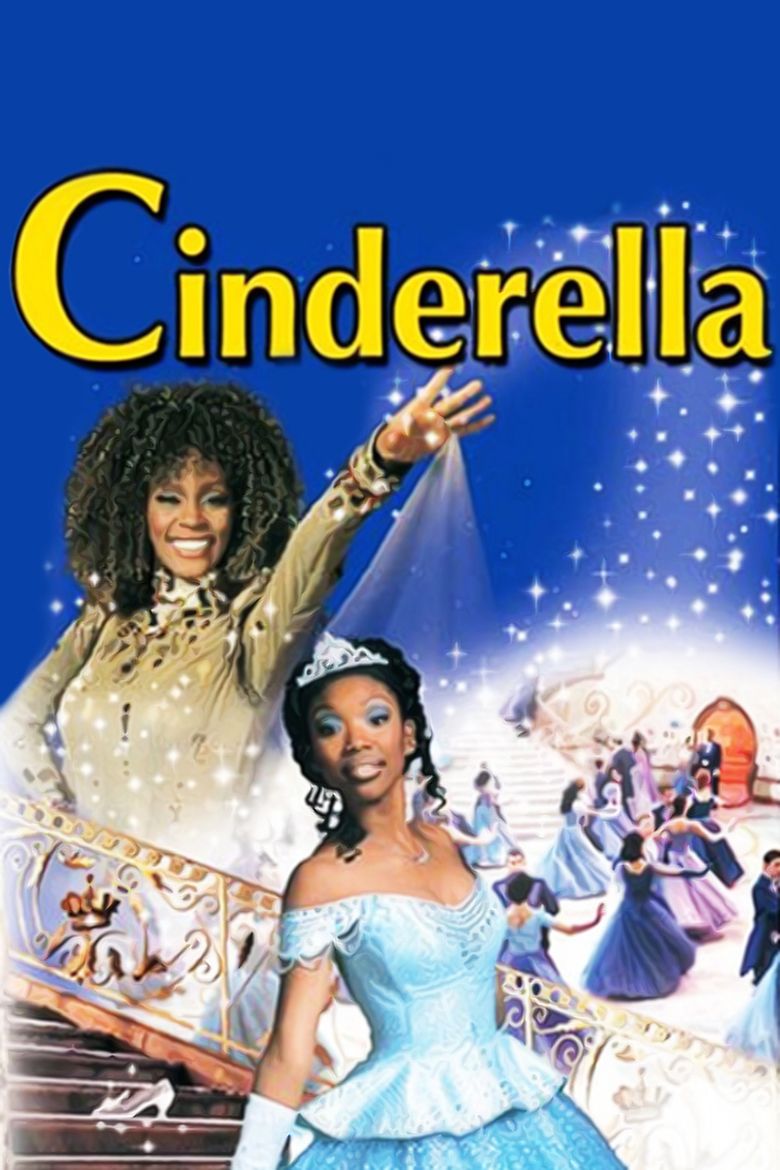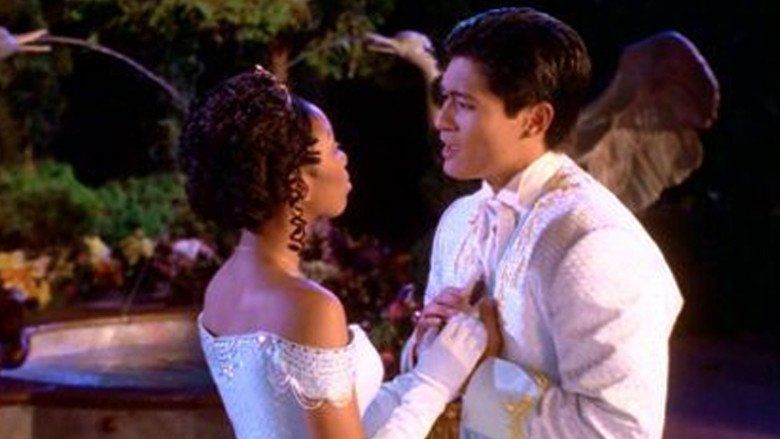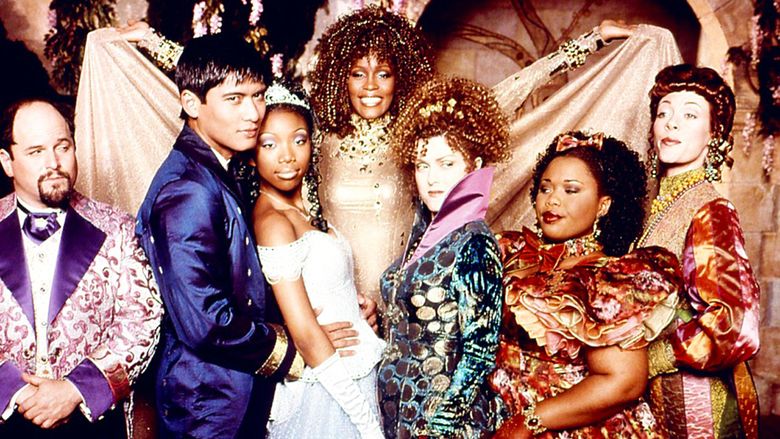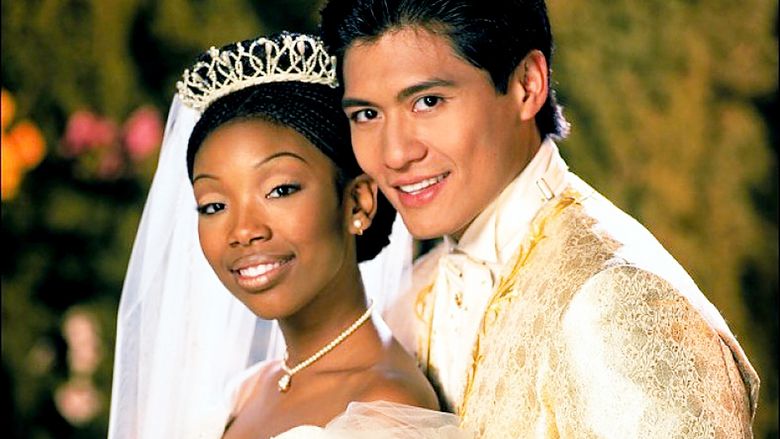Cinderella (1997 film)
6.6 /10 1 Votes
Duration Country United States | 6.4/10 IMDb Language English | |||||||||||||||||||||||||||||||||
 | ||||||||||||||||||||||||||||||||||
Release date November 2, 1997 Cast Brandy Norwood (Cinderella), (Fairy Godmother), (Queen Constantina), (Cinderella's Stepmother), (Lionel)Similar movies The Glass Slipper (1955), Ever After (1998), The Slipper and the Rose (1976), Cinderella III: A Twist in Time (2007), Into the Woods (2014) | ||||||||||||||||||||||||||||||||||
Whitney houston brandy impossible it s possible from r h s cinderella 1997
Rodgers & Hammerstein's Cinderella, commonly shortened to Cinderella, is a 1997 American made-for-television romantic musical fantasy film from The Wonderful World of Disney, directed by Robert Iscove, adapted by Robert L. Freedman with choreography by Rob Marshall, and produced by Walt Disney Television, BrownHouse Productions and Storyline Entertainment. It stars Brandy Norwood as the titular character, with Jason Alexander, Victor Garber, Whoopi Goldberg, Whitney Houston, Bernadette Peters, Veanne Cox, Natalie Desselle, and introduces Paolo Montalban.
Contents
- Whitney houston brandy impossible it s possible from r h s cinderella 1997
- Plot
- Cast
- Production
- Casting
- Release
- Home media
- Reception
- Musical numbers
- Awards
- References

It is based on the fairy tale by Charles Perrault, and is the third version of Rodgers & Hammerstein's television movie musical, following the 1957 and the 1965 versions.

Cinderella premiered on ABC November 2, 1997 and received mixed reviews from critics, but was the #1 show of the week, with over 60 million viewers. It became the highest-rated TV musical "in years". This version earned an Emmy Award and an Art Directors Guild Award.

Plot

Cinderella's Fairy Godmother (Whitney Houston) explains that nothing is impossible in this magical kingdom. In the village, Cinderella (Brandy) struggles under the weight of the purchases of her ill-tempered Stepmother (Bernadette Peters) and her spiteful stepsisters Minerva (Natalie Desselle-Reid) and Calliope (Veanne Cox). Cinderella's imagination wanders ("The Sweetest Sounds"). Disguised as a peasant, Prince Christopher (Paolo Montalban) is also strolling through the marketplace. The two meet when the Prince rushes over to help Cinderella after she is nearly crushed by the royal carriage. They begin to talk and realize they are both dissatisfied with their sheltered lives. She is charmed by his sincere, direct nature, while he is drawn to her naïve honesty and purity. Their conversation is cut off when Cinderella's Stepmother scolds her for talking to a stranger. The Prince reluctantly leaves, but tells Cinderella that he hopes to see her again.
Back at the palace, the Prince tries to explain his sense of isolation to his loyal valet Lionel (Jason Alexander), who frantically upbraids him for his clandestine venture into the village. He learns that his mother Queen Constantina (Whoopi Goldberg) is making preparations for a ball where he is to select a suitable bride from all the eligible maidens in the kingdom. The Prince wishes to fall in love the old-fashioned way; his father King Maximilian (Victor Garber) seems to understand, but the Queen will not listen, and dispatches Lionel to proclaim that "The Prince is Giving a Ball." Meanwhile, the Stepmother is determined to see one of her graceless, obnoxious and self-indulgent daughters chosen as the Prince's bride at the ball; she begins to plan their big night. Cinderella wonders if she, too, might go to the Prince's ball. Finding the idea humorous, Stepmother reminds Cinderella of her lowly station and warns against dreams of joy, success, and splendor. Disappointed, Cinderella dreams of a world away from her cold and loveless life ("In My Own Little Corner").
While the preparations for the ball are underway, the Prince confronts his parents, who refuse to cancel it. Using his diplomatic skills, Lionel creates a compromise between the Prince and his parents: the Prince will go to the ball, but if he doesn't meet a suitable bride that night then he gets to seek his true love in his own way. At the same time, Stepmother drills Minerva and Calliope on how to ensnare the Prince and warns them to hide their flaws at all costs. As Cinderella questions the meaning of love and romance, Stepmother reminds the girls that going to the ball has nothing to do with finding love and everything to do with getting a husband by any means necessary ("Falling in Love With Love"). On the big night, Stepmother, Minerva and Calliope depart for the palace in their garish gowns and leave a teary-eyed Cinderella home alone.
In response to Cinderella's tearful wish to go to the ball, the beautiful Fairy Godmother appears and encourages Cinderella to start living her dreams ("Impossible"). She transforms a pumpkin into a gilded carriage, rats into a coachman and footmen, mice into regal horses, and Cinderella's simple clothes into a gorgeous blue gown with a bejeweled tiara and glass slippers. The Fairy Godmother cautions Cinderella that magic spells have time limits, and she must leave the palace before the stroke of midnight. Cinderella finally begins to believe "It's Possible" for her dreams to come true.
At the ball, Lionel dutifully delivers eligible maidens to the Prince on the dance floor, and Stepmother fiendishly schemes behind the scenes on behalf of her daughters. The Prince is unimpressed by Minerva, who breaks out in an itchy rash, and Calliope, who snorts uncontrollably at everything the Prince says. Suddenly, Cinderella appears at the top of the staircase, and the Prince has eyes only for her. Soon they are waltzing together ("Ten Minutes Ago"), and the "Stepsisters Lament" over their bad luck. The King and Queen are intrigued by this mysterious princess. Embarrassed by their questions about her background, Cinderella escapes to the garden in tears, where Fairy Godmother magically appears for moral support. The Prince follows Cinderella into the garden and the pair wonders if their newfound love is real ("Do I Love You Because You're Beautiful?"). Just as they share their first kiss, the tower clock begins to strike midnight. Cinderella flees before her gown changes back into rags, leaving behind on the palace steps a single clue to her identity: a sparkling glass slipper. The Prince tries to follow her but gets held up by the crowd at the ball.
Stepmother and the Stepsisters return home telling exaggerated stories about their glorious adventures with the Prince. They speak in envious tones of a mysterious "Princess Something-or-other" who, they concede, also captured the Prince's attention. When Cinderella "imagines" how an evening at the ball would be "A Lovely Night", Stepmother recognizes her as the mystery princess. She coldly reminds Cinderella that she is common-born and should stop dreaming about a life that she will never have. In the face of such cruelty, a devastated Cinderella prays to her late father for the strength to find a happier life. Her Fairy Godmother reappears and advises her to share her feelings with the Prince.
Meanwhile, Lionel and the heartbroken Prince seek the maiden who lost the glass slipper, but none of the eligible female feet in the kingdom measure up. The Prince and Lionel finally arrive at the Stepmother's cottage. The Stepsisters and even Stepmother try to fit their feet into the delicate slipper, but to no avail. As the dispirited Prince prepares to leave, he finds Cinderella attempting to run away, only to have her baggage trampled by the royal coach. He recognizes her from their first meeting in the market and, knowing that he has finally found his true love, places the slipper on her foot: it fits.
Cinderella and the Prince marry under the approving eye of King Maximilian and Queen Constantina, as the gates of the palace slam shut on Cinderella's stepfamily; left outside as the Prince and his new Princess start their lives together. The Fairy Godmother blesses the royal couple with the message that "There's Music in You", as they are cheered by their joyful subjects.
Cast
Production
Rodgers & Hammerstein's Cinderella was a co-production of Walt Disney Television, Citadel, Craig Zadan and Neil Meron (Storyline Entertainment) and Whitney Houston's production company BrownHouse, labeled as "Walt Disney and Whitney Houston present".
This was the third version of the musical; the original was broadcast in 1957 and there was another version in 1965. According to news reports, "Disney spent roughly $12 million to produce Cinderella – more than three times the usual budget on a made-for-TV movie." The cast is "multi-cultural...Every family is a racially blended family." For example, "Cinderella (Brandy, who is African-American), has a white stepmother,...a white stepsister,...and a [sic] African-American stepsister."
Several songs were added to this version. "The Sweetest Sounds" from Rodgers' No Strings, was added, sung by Cinderella and the Prince. "There's Music in You," written by Rodgers and Hammerstein for the 1953 film Main Street to Broadway, was sung as the finale by the Fairy Godmother.
The New York Times explains: "To show the stepmother as not just an evil harridan but the product of bitter experience, the team proposed "Falling in Love With Love," which Rodgers wrote with his first partner, Lorenz Hart, for The Boys from Syracuse...'We were pretty much against it until they cast it, and then we knew that Bernadette would be able to put a different kind of spin on it,' said the composer's daughter, Mary Rodgers. In the new show, Ms. Peters sings the song to her daughters, warning them not to confuse the emotional notion of love with the commercial concept of marriage."
Casting
When Whitney Houston signed on to the film, she was listed as producer and in the role of Cinderella. However, she later asked Brandy to audition for the role of Cinderella, saying "I'm already 33 years old, and I want you to play Cinderella [...] someone who probably had a lot more energy and who was Cinderella to me...". Brandy only agreed to do the part if Houston played her fairy godmother, because she was her "idol".
Release
Rogers and Hammerstein's Cinderella premiered during The Wonderful World of Disney on ABC November 2, 1997.
Home media
Rogers and Hammerstein's Cinderella was released on VHS February 10, 1998, and DVD February 4, 2003 by Buena Vista Home Entertainment.
Reception
The television film was the #1 show of the week, with over 60 million viewers. It became the highest-rated TV musical "in years".
The television musical was a hit with audiences, but received mixed reviews from critics. Theatre historian John Kenrick called it a "hideous desecration" of the musical. Caryn James, writing in the New York Times praised the performers: Montalban has "an old-fashioned luxurious voice"; Jason Alexander "provides comic relief"; Goldberg "winningly blends royal dignity with motherly meddling"; Peters "brings vigor and sly comedy". She commented that the musical "was always a pumpkin that never turned into a glittering coach... the songs are lesser Rodgers and Hammerstein... it doesn't take that final leap into pure magic. Often charming and sometimes ordinary, this is a cobbled-together Cinderella for the moment, not the ages." Also she stated that lead actress Brandy "As Disney's Cinderella for the 90's is amazingly good." She also addressed the multi-racial cast: "There is no cause to wonder why one stepsister is black and one white. The entire kingdom is blissfully multiethnic, with a black queen in Ms. Goldberg, a white king in Victor Garber and the Philippine-born Paolo Montalban as their son. (The fact that this racial utopia exists in a fairy tale only emphasizes its distance from reality.)" Other critics praised the presentation. The Atlanta Journal and Constitution wrote: "Grade: A, a version both timely and timeless." The San Diego Union-Tribune agreed: "this version has much to recommend it." An encore broadcast on Valentine's Night 1999 drew another 15,000,000 viewers." Positive aspects of the movie according to O'Gorman are "a multi-ethnic cast, the addition of two new songs and a hip attitude." Bhob Stewart from the All Movie Guide referred to this adaptation as "rainbow Cinderella".
Musical numbers
- "Prologue" – Whitney Houston
- "Overture" – Orchestra
- "The Sweetest Sounds" – Brandy & Paolo Montalbán
- "The Prince is Giving a Ball"/"Your Majesties" – Jason Alexander, Whoopi Goldberg, Bernadette Peters, Veanne Cox, Natalie Desselle-Reid
- "In My Own Little Corner" – Brandy
- "Falling in Love with Love" – Bernadette Peters, Veanne Cox & Natalie Desselle-Reid
- "In My Own Little Corner" (reprise) – Brandy
- "Impossible" – Brandy & Whitney Houston
- "It's Possible" – Brandy & Whitney Houston
- "Ten Minutes Ago" – Brandy & Paolo Montalbán
- "Stepsisters' Lament" – Veanne Cox & Natalie Desselle-Reid
- "Do I Love You Because You're Beautiful?" – Paolo Montalbán & Brandy
- "A Lovely Night" – Brandy, Veanne Cox, Natalie Desselle-Reid & Bernadette Peters
- "Do I Love You Because You're Beautiful?" (reprise) – Whoopi Goldberg & Paolo Montalbán
- "Finale Ultimo" – Whitney Houston
- "There's Music in You" – Whitney Houston
Awards
References
Cinderella (1997 film) WikipediaCinderella (1997 film) IMDb Cinderella (1997 film) themoviedb.org
